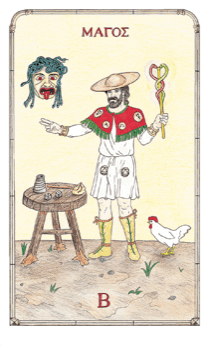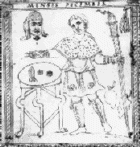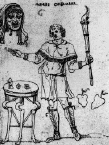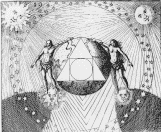
The Magician is the creator of a new cosmos. He allows us temporary entry into another world so that we may be transformed and reborn into the mundane world (cf. Hermes leading Orpheus into the Underworld and back). In the Saturnalia (and Carnival), Hermes is released into the world to recreate it - a recreation - and through him the limitless vitality of the Fool is given purpose, direction and intent.
However, to create a new cosmos (order), the old cosmos must be turned upside down. Thus the Magician Hermes is the Lord of Contradiction. First, he is himself a contradictory figure: trickster yet savior, king of misrule yet obedient to justice, deceiving orator yet honest prophet, illusionist yet revealer of truth, fraudulent conjurer yet genuine mage, thief yet honest trader, diabolical yet angelic, material yet spiritual. Second, he governs contradiction, and shows the way that finds unity in opposition. In particular, he governs the transformation of a bad situation into a good outcome. Remember that on the day of his birth Hermes stole Apollo's cattle, tricked him and lied about it, yet these crimes eventuated in Apollo receiving the lyre and becoming the patron of the arts, and in Hermes becoming the patron of divination and shepherds. Hermes teaches us that the worst evils can be transformed to good. He provokes us into new insights.
The Magician is one of the four Agents of Transformation (the others being X.Fortune, XI.Time and XVI.Star). He is the psychopomp, who leads Souls across boundaries into new realms. He is the Guide or Teacher we encounter just when they're needed most, or just when we're ready to understand what they have to say. He is the one who leads us to the book that we happen to look at and buy on a whim, and which is later enormously valuable to us. He is the source of the overheard remark that leads us on a path of change. When we benefit from synchronicity, Hermes deserves our thanks.




Traditionally this trump has been called the Magician (il Mago), the Juggler (le Bateleur, der Gaukler), the Mountebank, and even the Thimble-rigger (le Joueur de Gobelets). Furthermore, in many languages the word for magician has two senses: an authentic magician and a charlatan (e.g., Greek Goes, Magos). Moakley (62-3) identifies the Magician (il Bagatino, il Bagatto) with the Little Juggler Bagatino, a clown in commedia dell'arte, who is identified with the Carnival King. Occultists may deplore this ambiguity, but it's inherent in the nature of Hermes, for he is simultaneously the Magician, the Trickster, the Crafty One and the Thief (see Brown, Hermes). He is called shifty and the skin-changing (versipellis), the god of illusion and delusion (Jung, Sp. Merc. 217, 247).
The antinomian or contradictory nature of Hermes is well attested; he is called duplex, of two natures, male and female, heaven and earth, mother and father, young and old, strong and weak, etc. etc. (Jung, Sp. Merc. 216-8, 237). As Jung (Sp. Merc. 241) says, "In comparison with the purity and unity of the Christ symbol, Mercurius-lapis is ambiguous, dark, paradoxical, and thoroughly pagan. ... The paradoxical nature of Mercurius reflects an important aspect of the self - the fact, namely, that it is essentially a complexio oppositorum, and indeed can be nothing else if it is to represent any kind of totality." He continues (245-6): "The magic of his name enables him, in spite of his ambiguity and duplicity, to keep outside the split, for as an ancient pagan god he possesses a natural undividedness which is impervious to logical and moral contradictions. This gives him invulnerability and incorruptibility, the very qualities we so urgently need to heal the split in ourselves."
Further evidence for Hermes as the Carnival King is provided by the Hermaea, an ancient Cretan festival in his honor at which masters and slaves traded places, as in the Saturnalia and Kronia (OCD, s.v. Hermes).
The Magician is called the Lord of Chance because Hermes is also the patron of the Happy Coincidence (beneficial synchronicity, as we might say): the chance encounter, the unexpected find (so-called hermeia - "gifts of Hermes"), the overheard word (Brown, Hermes). The kledon, or accidentally significant utterance, is the basis for Hermes' own system of divination, in which, after prayer, one covers one's ears until in the marketplace, and then uncovers them and takes the first word heard as an omen (OCD, s.v. Hermes). From Apollo he learned astragalomancy and divination by dice. Finally, Hermes is the god of games of chance (Larousse 123). Jung (Sp. Merc. 240) compares him to the "daemonic serpent, Lilith or Melusina who lives in the tree, prods and persuades us to knowledge."
Since the Magician is King of Misrule, he reverses the order of nature (Jung, Sp. Merc. 218). His every whim is law, so those subject to his capricious orders know him as the Lord of Chance. Some he may make emperors, others slaves; some he may make priests, others he marries. His capriciousness contrasts with the inevitable ascent and descent of the Wheel of Fortune (the Lady of Chance).
See Nettleship & Sandys (s.v. Hermes) for a description and illustration of this form of the Caduceus. Its shape represents both the three nadis of yoga and the Cosmic Tree, with its threefold trunk, known throughout the ancient Middle East (Butterworth, Tree, passim). These nadis (Ida, Pingala and Shushumna) are the channels up which the Kundalini or serpent power is drawn, which reminds us that the Magician is the first card of the Triumph of Love (I through VI in the Ferrara sequence). The two serpents represent male and female wisdom interweaving in the nervous system (Shushumna, the spine). As Arrian said in the Discourses of Epictetus, "This Wand of Hermes: touch what you will with it, they say, and it becomes gold. Nay, but bring what you will and I will transmute it into Good."
The Magician (I) is the alchemical Mercury who will unite the Salt of the Empress (II) and the Sulphur of the Emperor (III); he will preside over the marriage of the lunar High Priestess (IV) to the solar High Priest (V), oversee its consummation in Love (VI), and deliver the child Temperance (VII). The Magician leads the Triumph of Love (I-VI).
The vas Hermeticum (Hermetic vessel), in which the alchemical operation takes place, is round to represent the miniature cosmos to be created within it; it is Hermetically sealed - that is sealed with the sign of Hermes - to separate it from the outside world (Jung, Sp. Merc. 197). In exactly this way the Magician creates a new world in his domain, isolated from the ordinary world. Alchemy is as ambiguous as Hermes. It's quite possible that it originated in procedures for dying metals and stones - which of course could be used for either legitimate or fraudulent purposes.
The Mercurius philosophicus (philosophical Mercury) is routinely described in contradictory terms, for it is a unification of opposites. For example, dry water (aqua sicca), water not wetting the hands (aqua manus non madefaciens), etc. (Jung, Sp. Merc. 207).
All the elements are united in Hermes. His connection with the Fool is shown by his many associations with Air. Hermes was originally a wind god; he travels through the air and corresponds to Thoth, who makes souls breath. In its most basic sense, spiritus is moving air. He is also connected with the element Earth, since he represents the Spiritus Mundi (Spirit of the Earth), the interpenetration of spirit and matter. Most importantly, he is the fiery water and the watery fire. (Jung, Sp. Merc. 212-3, 215-9)
The cock which accompanies the herald is taken to be a symbol of vigilance, since it heralds the coming of dawn. Likewise Hermes is the God who puts people to sleep and wakes them at dawn, and so he is called the Light Bringer (Phosphoros, Lucifer), as is the cock. (Hermes brings both obscurity and illumination, dreams and clarity.) Finally, we must not forget that the cock is a sexual symbol (hence the slang), due to his aggressiveness and eagerness to mate. (See Biedermann 288; Stassinopoulos 197) Hermes' erection recalls his most common representation: the ithyphallic herms that stood outside almost every Athenian home. Mercury is the spiritus vegetativus, a nature deity who is closely associated and sometimes identical with Venus (Jung, Sp. Merc. 195-6, 202, 215-6, 226).
As the Light Bringer (Phosphoros, Lucifer), a morning star (Stella Matutina), Mercury is not himself the light, but heralds the dawning of self-knowledge, the cognitio matutina. Alchemically, he brings the Sunlight to Earth - the Mercury (Spirit) joining the Sulphur (Soul) to the Salt (Body) (Pernety 108). His alter ego, Venus, is also called Stella Matutina and Lucifer. As evening stars (Stellae Verspertinae), with the assistance of Cupid (their son by some accounts), they herald the descent back into the cognitio vespertina, the world of sense and natural consciousness (see VI.Love). So the cycle continues. (Jung, Sp. Merc. 247-8)
Hermes is often shown wearing the petasos, which is nearly identical to the hat worn by the Magician in many Tarot decks. Moakley (63, 113) claims that red is the characteristic color of the Carnival King and of the Baggatino (Little Juggler) of commedia dell'arte, and it is still the color of the Magician in most Tarot decks, as it was in the earliest (e.g. Visconti-Sforza, c.1450). In these decks the Magician also wears some green, a color associated with Venus and Mercury (Jung, Sp. Merc. 226).
The Magician, dressed in red, is the natural enemy of the Idiot, who will dress in white at the end of the Saturnalia (Moakley 115), in well-known alchemical symbolism. For example, Rulandus, in his Lexicon of Alchemy (1612), says of Mercury that, "When he conquers, he is white; when overcome, he is red." Thus when the Magician has triumphed and his purification is complete, he will throw off his red cloak and show himself in white robe of innocence and purity. Similarly, Case (32, 43) explains that the red cloak represents "desire, passion and activity," which the Magician can take up or put aside at will; his white robe represents "the light of perfect wisdom," which always underlies his actions.
The manuscripts of the Calendar of 354 differ with regard to the spots showing on the dice. Therefore I've shown (1) snake eyes (two aces), the throw I've tentatively associated with the Magician; (2) two caters (fours), since Hermes was born on the fourth day of the fourth month, and the number four is sacred to him; (3) two sinks (fives), because 55 represents the totality of the decad and thus the cosmos: 55 = 1 + 2 + ... + 9 + 10. The Magician's two extended fingers, which match the snake eyes, show that he has been chosen by lot to be the King of the Saturnalia. Thus, he is reborn as Hermes (4, 4) and for the duration of the Saturnalia he governs the cosmos (55). (For what it's worth, in the Water Hexactys, two caters corresponds to the Star, the Lady of Necessity, and two sinks corresponds to the Judgement; in the Fire Hexactys, two caters corresponds to the Wheel, the Lady of Chance, and two sinks corresponds to the Tower.)
The pyrgos (Greek "tower") or turricula (Latin "little tower"), which is shown in the Calendar of 354, is a dice cup in the shape of a tower with steps; it's a miniature of the tower in the Tower trump (Salzman 74; Guhl & Koner 270; Koller s.v. fritillus, a synonymous Latin term).
The Magician corresponds to Saturn (Cronos) as well as Hermes, for the two are closely related. Sometimes Saturn is Mercurius Senex (Mercury Senior); other times Mercurius Iuvenis (Mercury Junior) is Saturn's son. Like Mercury, Saturn may be a hermaphrodite and a unification of opposites. In alchemy both Mercury and Saturn may be the red and green lions, and they both represent the prima materia. Both are the Mediator, who is responsible for transforming evil into good. (Jung, Sp. Merc. 226-8, 235)
The Saturnalia and the Carnival last seven days (Dec. 17-23), each ruled by a planet. The last day, Saturn's day, is ruled by Saturnus Lucifer, who heralds the coming light of self-knowledge, cognitio matutina (morning consciousness), which arrives on the Sun's day (Jung, Sp. Merc. 248-50).
The character of the Magician is given by the numerical value of ERMHS O AKAKHTA QEOS (Hermes Ho Akaketa Theos, The Gracious God Hermes) = 1058, which reduces to 8-5+0-1 = 2. The correspondence with Saturn is shwon by the numerical value of KRONOS OURANIDHS O QEOS (Kronos Ouranides Ho Theos, The God Kronos, son of Ouranos) = 1707, which reduces to 7-0+7-1-11 = 2. Both show the Magician to have the character of the Dyad, which, for the Pythagoreans, represents action directed toward an end, which gives purpose to the Monad (0.Idiot), a principle of initiative, impulse, change and contradiction. (TA 8-9, 11; see also the meaning of Beta, above, and the discussion of the Twos in the Minor Arcana)
Further evidence of the correspondence of the Magician and Saturn: The Fool corresponds to the primordial Chaos, and the Lord and Lady of Chance (1.Magician and 10.Fortune) correspond to the first divine couple, Saturn and Rhea, who ruled in the Golden Age. They are the Yang and Yin that come from the Tao and beget the gods of the First Ogdoad (the Personal Triumphs), corresponding to the eight trigrams. Conversely, the Second Ogdoad (the Universal Triumphs) progresses into a new Golden Age, ruled again by Cronos and Rhea, but now in their roles as Lord and Lady of Necessity (11.Time and the 16.Star). They reunite into the hermaphroditic Cosmos (21), that is, the Yang and Yin reunite in the Tao. This will be explained more fully when those cards are discussed.
 Send comments about this page
Send comments about this page
Last updated
Mon Jun 7 16:17:37 EDT 1999